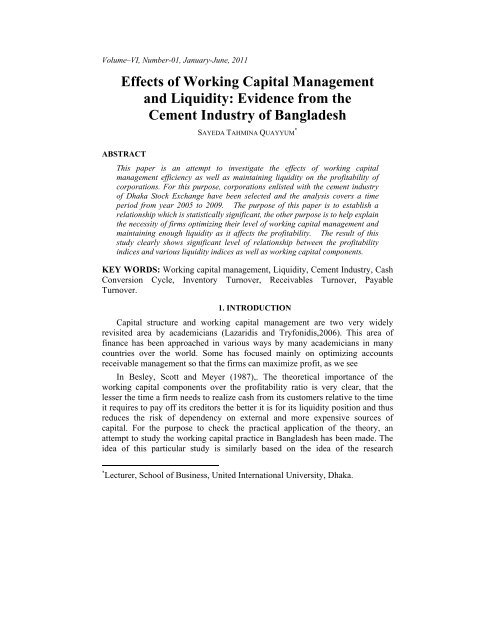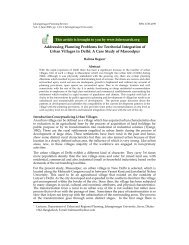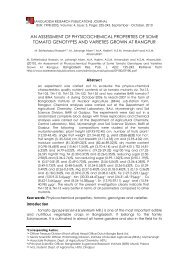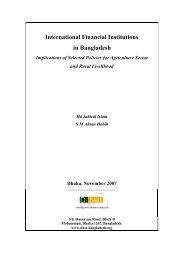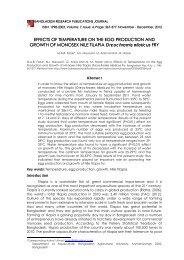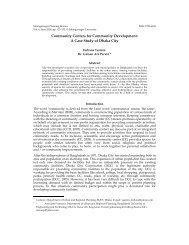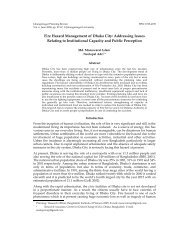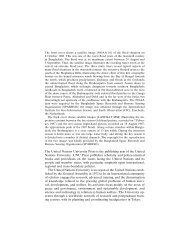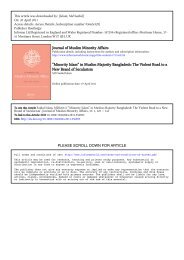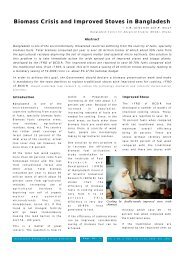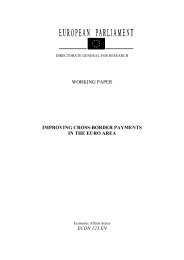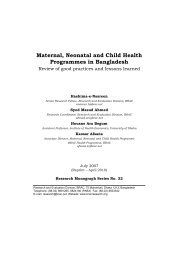Effects of Working Capital Management and Liquidity - Bangladesh ...
Effects of Working Capital Management and Liquidity - Bangladesh ...
Effects of Working Capital Management and Liquidity - Bangladesh ...
Create successful ePaper yourself
Turn your PDF publications into a flip-book with our unique Google optimized e-Paper software.
Volume–VI, Number-01, January-June, 2011<strong>Effects</strong> <strong>of</strong> <strong>Working</strong> <strong>Capital</strong> <strong>Management</strong><strong>and</strong> <strong>Liquidity</strong>: Evidence from theCement Industry <strong>of</strong> <strong>Bangladesh</strong>SAYEDA TAHMINA QUAYYUM *ABSTRACTThis paper is an attempt to investigate the effects <strong>of</strong> working capitalmanagement efficiency as well as maintaining liquidity on the pr<strong>of</strong>itability <strong>of</strong>corporations. For this purpose, corporations enlisted with the cement industry<strong>of</strong> Dhaka Stock Exchange have been selected <strong>and</strong> the analysis covers a timeperiod from year 2005 to 2009. The purpose <strong>of</strong> this paper is to establish arelationship which is statistically significant, the other purpose is to help explainthe necessity <strong>of</strong> firms optimizing their level <strong>of</strong> working capital management <strong>and</strong>maintaining enough liquidity as it affects the pr<strong>of</strong>itability. The result <strong>of</strong> thisstudy clearly shows significant level <strong>of</strong> relationship between the pr<strong>of</strong>itabilityindices <strong>and</strong> various liquidity indices as well as working capital components.KEY WORDS: <strong>Working</strong> capital management, <strong>Liquidity</strong>, Cement Industry, CashConversion Cycle, Inventory Turnover, Receivables Turnover, PayableTurnover.1. INTRODUCTION<strong>Capital</strong> structure <strong>and</strong> working capital management are two very widelyrevisited area by academicians (Lazaridis <strong>and</strong> Tryfonidis,2006). This area <strong>of</strong>finance has been approached in various ways by many academicians in manycountries over the world. Some has focused mainly on optimizing accountsreceivable management so that the firms can maximize pr<strong>of</strong>it, as we seeIn Besley, Scott <strong>and</strong> Meyer (1987),. The theoretical importance <strong>of</strong> theworking capital components over the pr<strong>of</strong>itability ratio is very clear, that thelesser the time a firm needs to realize cash from its customers relative to the timeit requires to pay <strong>of</strong>f its creditors the better it is for its liquidity position <strong>and</strong> thusreduces the risk <strong>of</strong> dependency on external <strong>and</strong> more expensive sources <strong>of</strong>capital. For the purpose to check the practical application <strong>of</strong> the theory, anattempt to study the working capital practice in <strong>Bangladesh</strong> has been made. Theidea <strong>of</strong> this particular study is similarly based on the idea <strong>of</strong> the research* Lecturer, School <strong>of</strong> Business, United International University, Dhaka.
38Journal <strong>of</strong> Business <strong>and</strong> Technology (Dhaka)conducted by Lazaridis <strong>and</strong> Tryfonidis (2006) in Greece. This study is tomeasure the extent <strong>of</strong> dependency <strong>of</strong> pr<strong>of</strong>itability over working capitalcomponents for <strong>Bangladesh</strong> context.2. LITERATURE REVIEWThe attention <strong>of</strong> academicians <strong>and</strong> managers over optimizing working capitalcomponents is not very new, rather, many have provided with a variety <strong>of</strong>thoughts for the welfare <strong>of</strong> businesses over many years. For over 25 years ago,Largay <strong>and</strong> Stickney (1980, p. 53) had reported the importance <strong>of</strong> cash positionfor sustainability <strong>of</strong> the firm. Lazaridis <strong>and</strong> Tryfonidis (2006), had found arelationship between working capital management efficiency <strong>and</strong> pr<strong>of</strong>itability<strong>and</strong> so did Shin <strong>and</strong> Soenen (1998), Delo<strong>of</strong> (2003) <strong>and</strong> many others. Thus it wasobvious that the firms would have to suffer if it does not take steps to minimizetheir dependency on external sources <strong>of</strong> funds.According to Delo<strong>of</strong> (2003) the way that working capital is managed has asignificant impact on pr<strong>of</strong>itability <strong>of</strong> firms. It has also been proved that byminimizing the amount <strong>of</strong> funds tied up in current assets; firms can reducefinancing costs <strong>and</strong>/or increase the funds available for expansion. Summers <strong>and</strong>Wilson (2000) report that in the UK corporate sector more than 80% <strong>of</strong> dailybusiness transactions are on credit terms. Cote <strong>and</strong> Latham (1999, p. 261) arguedthe management <strong>of</strong> receivables, inventory <strong>and</strong> accounts payable have tremendousimpact on cash flows, which in turn affect the pr<strong>of</strong>itability <strong>of</strong> firms. As found byLazaridis <strong>and</strong> Tryfonidis (2006), companies enjoy better pricing when they holdenough cash to purchase from own suppliers <strong>and</strong> thus they may enhance theirpr<strong>of</strong>it. So having enough liquidity also affects the pr<strong>of</strong>itability <strong>of</strong> the firm.As found by Long, Malitz <strong>and</strong> Ravid (1993) it is seen that liberal credit termsto the customers increase the sales level <strong>of</strong> the firm, though having a continuoustrouble with managing short term financing in the finance department. Butextensive use <strong>of</strong> liberal credit terms to customers reduces the pr<strong>of</strong>itability <strong>of</strong> thefirm. It is up to the firm depending on its nature <strong>of</strong> business to decide whether tochoose liberal credit terms to enhance marketing to the customers or to focus onpr<strong>of</strong>itability <strong>of</strong> the firm with minimizing its cash conversion cycle <strong>and</strong> optimizelevel <strong>of</strong> cash holdings.Moyer, Mcguigan <strong>and</strong> Kretlow (1995, p. 11) found that WC consists <strong>of</strong> alarge portion <strong>of</strong> a firm’s total investment in assets, 40 percent in manufacturing<strong>and</strong> 50% - 60% in retailing <strong>and</strong> wholesale industries respectively. Scherr (1989,p. 16) claimed that by implementing best practices in WC, companies canstrengthen strong cash flow levels, improve pr<strong>of</strong>itability, budgeting <strong>and</strong>forecasting process.
Quayyum: <strong>Effects</strong> <strong>of</strong> <strong>Working</strong> <strong>Capital</strong> <strong>Management</strong> <strong>and</strong> <strong>Liquidity</strong> 39As stated by Siddiquee <strong>and</strong> Khan (2009), it has been observed that, firmswhich are better at managing working capital are found to be able to makecounter cyclical moves to build competitive advantage. They are also better atgenerating fund internally <strong>and</strong> also face lesser trouble while seeking externalsources <strong>of</strong> financing.It is also consistent with this study, as this study also found to havesignificant level <strong>of</strong> positive relationship between better management <strong>of</strong> workingcapital <strong>and</strong> high pr<strong>of</strong>itability.3. DATA COLLECTION, VARIABLES AND METHODOLOGYData CollectionFor the purpose <strong>of</strong> this study, secondary data have been collected <strong>and</strong> thedata collected were from listed firms in the Dhaka Stock Exchange. The reasonfor choosing this source is primarily due to the better reliability <strong>of</strong> the financialstatements. Due to time constraint, only cement industry has been selected for thesaid research. The industry consists <strong>of</strong> five companies, due to unavailability <strong>of</strong>one company all years secondary data, four companies were taken as sample; thiscovers 80% <strong>of</strong> the population. The outliers had been adjusted to get betterreliable result. The duration covered in this study was from year 2005 to year2009 for this analysis. Finally the financial statements were obtained from theDhaka Stock Exchange Library.Methodology <strong>and</strong> VariablesAs mentioned earlier this research idea is based on the work done byLazaridis <strong>and</strong> Tryfonidis (2006). The methodology <strong>of</strong> this study is to find out thedependency <strong>of</strong> pr<strong>of</strong>itability ratios over many other working capital components<strong>and</strong> liquidity positions. To cover the liquidity position, few cash position ratioshave been considered along with traditional liquidity ratios. And for the purpose<strong>of</strong> the analysis, regression has been conducted.So the basic model for the study that has been followed is,Pr<strong>of</strong>itability <strong>of</strong> the Firm=f (Quick Ratio , Cash Conversion Cycle ,Receivables Collection Period (RCP), Payable Deferral Period , InventoryTurnover Period , Cash to Current Liability , Cash to Sales )The measure <strong>of</strong> working capital management is cash conversion cycle. And itis described by the following equation:Cash conversion cycle=Receivables collection period + Inventory turnoverperiod –Payable deferral period
40Journal <strong>of</strong> Business <strong>and</strong> Technology (Dhaka)For the purpose <strong>of</strong> analysis, the ultimate measurement <strong>of</strong> pr<strong>of</strong>itability hasbeen chosen to be return on asset (ROA). The method <strong>of</strong> calculating cashconversion cycle (CCC) has been shown earlier as well. The variables arecalculated as shown in the table following. Only the CCC <strong>and</strong> its componentshave a unit <strong>of</strong> days, except for these, all other variables are expressed in terms <strong>of</strong>proportion or ratio. The variables that have been used are as follows:No Variables Method used for Calculation1 Return On Asset (ROA) Net Pr<strong>of</strong>it / Total Asset2 Net Pr<strong>of</strong>it Margin (NPM) Net Pr<strong>of</strong>it / Sales3 Interest Coverage Ratio (ICR) Earnings Before Interest <strong>and</strong>Taxes/Interest Expense4 Quick Ratio (QR) (Current Asset - Inventory)/CurrentLiability5 Cash Conversion Cycle (CCC) RCP + PDP - ITP6 Receivables Collection Period (RCP) 360 / (Sales/ Accounts Receivables)7 Payable Deferral Period (PDP) 360 / (COGS/Accounts Payable)8 Inventory Turnover Period (ITP) 360 / (COGS/Inventory)9 Cash to Current Liability ( CTCL) Cash/Current Liability10 Cash to Sales (CTS) Cash/SalesThe ratio <strong>of</strong> cash to sales has been taken to have an idea if the companies areenjoying any benefit out <strong>of</strong> holding cash which reflects in the company’spr<strong>of</strong>itability. As it has been explained as a probable reason by Lazaridis <strong>and</strong>Tryfonidis (2006) that companies enjoy better pricing when they hold enoughcash to purchase from own suppliers. Cash to current liability has been taken toobserve if the companies are cautious enough to keep up with their maturing duesor obligations <strong>and</strong> if they are benefitting out <strong>of</strong> this performance as well.Many other variables have also been considered for the purpose <strong>of</strong> this study,but those have been excluded later as they do not show statistically significantrelationship with the dependent variables. Finally the dependent variables usedfor the research are mainly the pr<strong>of</strong>itability ratios <strong>and</strong> debt coverage ratio orROA, NPM <strong>and</strong> ICR respectively. But NPM <strong>and</strong> ICR has also been used asindependent variable to assess their impact on ROA.All other variables are considered to disclose the working capital condition orcash position <strong>of</strong> the firm <strong>and</strong> are used as independent variable against the earliersaid dependent variables.
Quayyum: <strong>Effects</strong> <strong>of</strong> <strong>Working</strong> <strong>Capital</strong> <strong>Management</strong> <strong>and</strong> <strong>Liquidity</strong> 414. ANALYSIS AND FINDINGSDescriptive StatisticsThe following table gives the descriptive statistics <strong>of</strong> the collected variables.The mean <strong>and</strong> median <strong>of</strong> net pr<strong>of</strong>it margin are very close to that <strong>of</strong> ROA, Whichmeans in most <strong>of</strong> the years these firms had a total asset turnover <strong>of</strong> 1. The CCCshows that, it takes the firm’s around 93 days on average (Median 113) to realizenet cash on selling <strong>of</strong> a particular good. While they paid their creditors prior toreceiving the sales proceed. Inventory takes on an average 58 days to get sold(median 33 days). There is a scope to h<strong>and</strong>le CCC with more efficiency.TABLE 1DESCRIPTIVE STATISTICS OF PROFITABILITY RATIOS ANDWORKING CAPITAL RATIOSMean Median St<strong>and</strong>ardDeviationSt<strong>and</strong>ardErrorConfidenceLevel (95%)ROA 0.05595 0.04416 0.04667 0.01205 0.02585NPM 0.05498 0.04327 0.04356 0.01125 0.02412ICR 7.79891 2.15969 13.62266 3.51736 7.54398QR 0.33437 0.47942 0.91545 0.23637 0.50696CCC 92.46761 112.79765 62.67980 16.18385 34.71092ITR 57.58620 32.30887 57.01169 14.72036 31.57202CTCL 0.17508 0.07436 0.27587 0.07123 0.15277CTS 0.05676 0.02792 0.06746 0.01742 0.03736In the following table 2 Pearson correlations for the variables have beenshown. We can see that the return on asset, net pr<strong>of</strong>it margin <strong>and</strong> interestcoverage ratio all are negatively correlated with the cash conversion cycle, whichindicate that more pr<strong>of</strong>itable firms either delay their payment towards theirsuppliers-creditors or accelerate their receivables.. These results are consistentwith the view that the shorter the period between production <strong>and</strong> sale <strong>of</strong> productsthe larger is the firm’s pr<strong>of</strong>itability. It is underst<strong>and</strong>able that companies with cashin h<strong>and</strong> can purchase raw materials from suppliers with better prices <strong>and</strong> alsomay take benefit in many other bargaining. Maybe that is the reason <strong>of</strong> cash tosales <strong>and</strong> cash to current liability are both having very high positive correlationwith interest coverage ratio. It is in line with the observation <strong>of</strong> Lazaridis <strong>and</strong>Tryfonidis (2006).
42Journal <strong>of</strong> Business <strong>and</strong> Technology (Dhaka)TABLE 2CORRELATION BETWEEN PROFITABILITY RATIOSAND WORKING CAPITAL RATIOSROA NPM ICR QR CCC ITR CTCL CTSROA 1.0000NPM 0.9178 1.0000ICR 0.6978 0.7102 1.0000QR 0.6837 0.5037 0.4923 1.0000CCC -0.7247 -0.5838 -0.5233 -0.4565 1.0000ITR 0.8341 0.7309 0.6061 0.5067 -0.9246 1.0000CTCL 0.6699 0.5493 0.9101 0.5746 -0.5814 0.6489 1.0000CTS 0.6982 0.5843 0.8351 0.5616 -0.6105 0.6996 0.9676 1.0000Regression AnalysisAs we have seen from the correlation table shown previously we get an ideaabout the relationship nature between variables but to analyze the extent <strong>of</strong>dependency <strong>of</strong> firms’ pr<strong>of</strong>itability on its working capital management, regressionanalysis has been conducted. In this study the working capital components <strong>and</strong>cash position indicators are the independent variables as said earlier.This study has focused on simple regression <strong>and</strong> multiple regressions both. Inthe first section, the single regression has been conducted over each individualdependent variable, i.e., ROA, NPM <strong>and</strong> ICR. The Second section covers theMultiple Regression model.Section 1: Single RegressionIn the Appendix Table-A, we see the result <strong>of</strong> single regression conducted forROA against 7 independent variables. The regression was also conducted againstfew other variables as mentioned previously, but had to be excluded later due tolack <strong>of</strong> statistical significance, for example, the receivables collection period <strong>and</strong>the payable deferral period, the current ratio etc. But current ratio when adjustedfor inventory <strong>and</strong> converted to quick ratio shows a significantly higher level <strong>of</strong>influence over the pr<strong>of</strong>itability ratios with much more reliability, this will beshown in the following parts <strong>of</strong> the study. And total debt to total asset althoughshowed a positive correlation <strong>of</strong> over 0.45 with CCC but the value was notstatistically significant when regression conducted.We can see from the Appendix A Table – (i), that all the results have a verydependable level <strong>of</strong> P Values. For better performance <strong>of</strong> ROA, the mostimportant independent variable is NPM which is very easily underst<strong>and</strong>able. Butthe purpose <strong>of</strong> the study is to assess the importance <strong>of</strong> <strong>Working</strong> <strong>Capital</strong>management. And we see that CCC has a negative effect on the ROA, <strong>and</strong> almost
Quayyum: <strong>Effects</strong> <strong>of</strong> <strong>Working</strong> <strong>Capital</strong> <strong>Management</strong> <strong>and</strong> <strong>Liquidity</strong> 4353% <strong>of</strong> the change in ROA can be explained with the change in CCC. This isquite a good level <strong>of</strong> explanatory power, as we know that for cross section data alevel <strong>of</strong> 55% <strong>of</strong> R Square is quite good. Among the components <strong>of</strong> CCC,inventory turnover ratio has an explanatory power <strong>of</strong> 70% over the change inROA. The regression equations derived from the study are:Model (a) : ROA = 0.105845 – 0.00054 *CCCModel (b) : ROA = 0.044295 + 0.034855 * QRModel (c) : ROA = 0.001883 + 0.98336 * NPMModel (d) : ROA = 0.037304 + 0.002391 * ICRModel (e) : ROA = 0.016628 – 0.00683 * ITPModel (f) : ROA = 0.036105 + 0.11331 * CTCLModel (g) : ROA = 0.0285311 + 0.483034 * CTSFrom the derived equations we see that, cash to current liability <strong>and</strong> cash tosales exert very high level <strong>of</strong> influence on the ROA. Especially if we look atmodel (g), the derived equation asserts that firms should focus on projecting theirfuture sales <strong>and</strong> hold cash as according to that, so that they can maximize theirlevel <strong>of</strong> ROA. The constraint faced by the firms in such a situation would be thelimitation <strong>of</strong> their cash financing capability <strong>and</strong> affordability <strong>of</strong> that financing.The single regression for net pr<strong>of</strong>it margin (NPM) shows result as following:Model (h) : NPM = 0.092494 – 0.00041 *CCCModel (i) : NPM = 0.046968 + 0.023966 * QRModel (j) : NPM = 0.037271 + 0.002271 * ICRModel (k) : NPM = 0.02282142 – 0.0005585 * ITPModel (l) : NPM = 0.039795 + 0.086736 * CTCLModel (m) : NPM = 0.033566 + 0.377284 * CTSFrom the resulting equations above we see that, for better performance <strong>of</strong>NPM, the most capable independent variable <strong>of</strong> explaining the change isinventory turnover period with an R Square <strong>of</strong> 0.534255 as we would see inAppendix- A, Table – (ii); it might be due to the pr<strong>of</strong>it margin <strong>of</strong> firms increasingwith increasing dem<strong>and</strong> <strong>of</strong> the product with a given level <strong>of</strong> fixed costs <strong>and</strong> lesserelastic costs. The CCC has a negative effect on the NPM, <strong>and</strong> almost 34.08% <strong>of</strong>the change in NPM can be explained with the change in CCC. Another importantindependent variable is interest coverage ratio. Almost 50.4376% <strong>of</strong> the changein NPM can be explained with the change in interest coverage ratio or ICR.From the derived equations we again see that cash to sales exerts a very highlevel <strong>of</strong> influence on the NPM. So, mathematically, the derived equation asserts
44Journal <strong>of</strong> Business <strong>and</strong> Technology (Dhaka)that firms should focus on forecasting their future sales <strong>and</strong> hold cash asaccording to that, so that they can maximize their level <strong>of</strong> NPM as well. Theconstraint faced by individual firms in such a situation would again be thelimitation <strong>of</strong> individual firms’ cash financing capability <strong>and</strong> affordability <strong>of</strong> thatfinancing.This regression equation is consistent with the findings <strong>of</strong> many other studiesover the world including Lazaridis <strong>and</strong> Tryfonidis (2006) that a decrease in thecash conversion cycle will generate more pr<strong>of</strong>its for a company.In order to have an idea whether a firm managing its working capitalefficiently enjoys any support in debt paying, a further test has been conducted.Considering interest coverage ratio as for the dependent variable <strong>and</strong> cashconversion cycle as independent variable the following result has been derived.TABLE 3SINGLE REGRESSION ANALYSIS FOR CEMENT INDUSTRY IN DSEDependentVariableIndependentVariableR SquareAdjusted RSquareCoefficient T-Stat P ValueICR CCC 0.273861 0.218004 -0.113740 -2.2143 0.04530The result shows a negative relationship with a coefficient <strong>of</strong> -0.113740though the R Square is quite less. So, there is a negative relationship betweenICR <strong>and</strong> CCC. This result is highly significant <strong>and</strong> does make economic sense,since the longer a firm delays its payments the higher level <strong>of</strong> working capitallevels it reserves <strong>and</strong> uses in order to increase pr<strong>of</strong>itability, this is also consistentwith the finding <strong>of</strong> Lazaridis <strong>and</strong> Tryfonidis (2006).Section 2: Multiple RegressionsA multiple regression shows the influence <strong>of</strong> multiple independent variableson a single dependent variable. In order to avoid redundancy effect on multipleregressions, few variables from the earlier said selected ones have beeneliminated. For instance, inventory turnover ratio, receivables turnover period,<strong>and</strong> payable deferral period they underlie within the cash conversion cycle. Cashpositions ratios are a part <strong>of</strong> quick ratio, NPM results out <strong>of</strong> interest coverageratio so cash position <strong>and</strong> NPM have been eliminated.Model – O: ROA= 0.069178 - 0.0003 CCC + 0.001092 ICR + 0.017523 QRSt<strong>and</strong>ard Error 0.000137 0.000646 0.009202The analysis has been done against cash conversion cycle, quick ratio <strong>and</strong>interest coverage ratio. In the above shown Model – O, we see that cashconversion cycle is having a negative relation with the ROA <strong>and</strong> the coefficient
Quayyum: <strong>Effects</strong> <strong>of</strong> <strong>Working</strong> <strong>Capital</strong> <strong>Management</strong> <strong>and</strong> <strong>Liquidity</strong> 45is -0.0003, this equation is very highly dependable as the P Value is only0.001277 as we see in Appendix –B. The explanatory power <strong>of</strong> the equation for achange in the ROA is also very high. Given that is a cross section dataevaluation; an R Square <strong>of</strong> 0.748 is very good. The dominant influential factorover the ROA is quick ratio, which is a measure <strong>of</strong> liquidity <strong>of</strong> the firm; thismeans the firms which are better at h<strong>and</strong>ling its liquidity as opposed to its currentdues are better at optimizing their use <strong>of</strong> assets <strong>and</strong> generating more pr<strong>of</strong>it. Thismakes sense, as the firms which make the best use out <strong>of</strong> their liquid assets <strong>and</strong>its financing are more likely to generate better production level <strong>and</strong> pr<strong>of</strong>itability.5. CONCLUSIONS AND RECOMMENDATIONSThis study finds a negative relationship between cash conversion cycle <strong>and</strong>pr<strong>of</strong>itability <strong>of</strong> the Firm. This complies with the finding <strong>of</strong> Shin <strong>and</strong> Soenen(1998) <strong>and</strong> Lazaridis <strong>and</strong> Tryfonidis (2006) <strong>and</strong> many others. This study extendsthe earlier said studies in the sense that this study shows a strong positiverelationship <strong>of</strong> pr<strong>of</strong>itability with the firms’ cash holding position along with otherindicators. And it also recommends that the firms should forecast their sales <strong>and</strong>hold cash enough as according to their projected sales level, so that they be ableto take advantage <strong>of</strong> the bargaining position while making purchases <strong>and</strong> thusreduce cost. It is very clear that the efficient management <strong>of</strong> working capital <strong>and</strong>liquidity has a positive effect on the firms’ pr<strong>of</strong>itability. So this study clearlyasserts that, firms in the cement industry in <strong>Bangladesh</strong> have enough scope toenhance their pr<strong>of</strong>itability by h<strong>and</strong>ling their working capital in more efficientways. Especially, the inventory turnover if h<strong>and</strong>led efficiently can produce asignificant positive impact on pr<strong>of</strong>itability <strong>of</strong> the firm.Thus this study finds enough evidences that a firm is likely to enjoy betterpr<strong>of</strong>itability if the firm manages its working capital with better efficiency <strong>and</strong>focuses on cash position with more care.REFERENCESBesley, Scott, & Meyer, R.L (1987). An Empirical Investigation <strong>of</strong> Factors Affecting theCash Conversion Cycle. Annual Meeting <strong>of</strong> the Financial <strong>Management</strong>Association, Las Vegas Nevada.Cote, J. M., & Latham, C. K.. (1999). The Merch<strong>and</strong>ising Ratio: A ComprehensiveMeasure <strong>of</strong> <strong>Working</strong> <strong>Capital</strong> Strategy. Issues in Accounting Education, 14(2), 255-267.Delo<strong>of</strong>, M. (2003). Does <strong>Working</strong> <strong>Capital</strong> <strong>Management</strong> Affect Pr<strong>of</strong>itability <strong>of</strong> BelgianFirms?. Journal <strong>of</strong> Business Finance & Accounting, 30 (3& 4), p. 585.Largay, J., & Stickney, C. (1980). Cash Flows, Ratio Analysis <strong>and</strong> the W. T. GrantCompany Bankruptcy. Financial Analyst Journal, pp. 51-54 12.
46Journal <strong>of</strong> Business <strong>and</strong> Technology (Dhaka)Lazaridis, I., Tryfonidis, D. (2005). The relationship between working capitalmanagement <strong>and</strong> pr<strong>of</strong>itability <strong>of</strong> listed companies in the Athens Stock Exchange.SSRN.com.[Online Available] http://papers.ssrn.com/sol3/papers.cfm?abstract_id=931591Long, M.S., Malitz, I.B., & Ravid, S.A (1993). Trade Credit, Quality Guarantees, <strong>and</strong>Product Marketability. Financial <strong>Management</strong>, 22(4), 117-127.Moyer R. C., Mcguigan J. R., Kretlow W. J. (1995). Contemporary Financial<strong>Management</strong>, West Publishing Co, Cincinati, Ohio.Pike R., Nam, S. C. (2001). Credit <strong>Management</strong>: An Examination <strong>of</strong> Policy Choices,Practices <strong>and</strong> Late Payment in UK Companies. Journal <strong>of</strong> Business Finance &Accounting, l 28(78),1013.Raheman, A., Nasr, M. (2007). <strong>Working</strong> <strong>Capital</strong> <strong>Management</strong> And Pr<strong>of</strong>itability – CaseOf Pakistani Firms. International Review <strong>of</strong> Business Research papers, 3(1), 279 –300.Scherr, F. C. (1989). Modern <strong>Working</strong> <strong>Capital</strong> <strong>Management</strong>, Text <strong>and</strong> Cases. EnglewoodCliffs, New Jersey: Prentice-Hall International Editions.Shin, H. H, Soenen, L. (1998). Efficiency <strong>of</strong> <strong>Working</strong> <strong>Capital</strong> <strong>Management</strong> <strong>and</strong>Corporate Pr<strong>of</strong>itability, Financial Practice <strong>and</strong> Education, 8(2),37-45.Siddiquee, M. M., & Khan, S. M. (2008). Analyzing <strong>Working</strong> <strong>Capital</strong> Performance:Evidence from Dhaka Stock Exchange (DSE) Ltd. The Journal <strong>of</strong> NepaleseBusiness Studies, III( 1).Summers B., Wilson, N. (2000). Trade Credit <strong>Management</strong> <strong>and</strong> the Decision to UseFactoring: An Empirical Study. Journal <strong>of</strong> Business Finance & Accounting, 27(1&2), 37- 68.Van Horne, J. C. & Wachowicz, J. M. 2000. Fundamentals <strong>of</strong> Financial <strong>Management</strong>,11th Ed. Prentice Hall Inc.Wilner, B. (2000). The Exploitation <strong>of</strong> Relationships in Financial Distress: The Case <strong>of</strong>Trade Credit. The Journal <strong>of</strong> Finance, 55(1), 153.
Quayyum: <strong>Effects</strong> <strong>of</strong> <strong>Working</strong> <strong>Capital</strong> <strong>Management</strong> <strong>and</strong> <strong>Liquidity</strong> 47APPENDIX - ASingle Regression Results <strong>of</strong> Dependent Variables:TABLE (I)SINGLE REGRESSION ANALYSIS FOR ROA OF CEMENT INDUSTRY IN DSEDependentVariableIndependentVariablesR SquareAdjustedR SquareCoefficient T-Stat P Value St<strong>and</strong>ardErrorROA CCC 0.525156 0.488629 -0.000540 -3.7918 0.00224 0.0334ROA QR 0.467407 0.426438 0.034855 3.37770 0.00495 0.0354ROA NPM 0.842342 0.830215 0.983360 8.33409 0.00000 0.0192ROA ITP 0.695719 0.672313 0.000683 5.45194 0.00011 0.0267ROA ICR 0.486943 0.447477 0.002391 3.51259 0.00382 0.0347ROA CTCL 0.448827 0.406430 0.113341 3.25363 0.00629 0.0359ROA CTS 0.487479 0.448054 0.483034 3.51636 0.00379 0.0347TABLE (II)SINGLE REGRESSION ANALYSIS FOR NPM OFCEMENT INDUSTRY IN DSEDependentVariableIndependentVariablesR SquareAdjusted RSquareCoefficient T-Stat P Value St<strong>and</strong>ardErrorNPM CCC 0.340767 0.290057 -0.000410 -2.59228 0.022331 0.0367NPM QR 0.253677 0.196267 0.023966 2.102077 0.055603 0.0239NPM ITP 0.534255 0.498429 0.000558 3.861643 0.001964 0.0309NPM ICR 0.504376 0.466251 0.002271 3.637249 0.003010 0.0318NPM CTS 0.341409 0.290748 0.377284 2.595979 0.022174 0.0367NPM CTCL 0.301749 0.248038 0.086736 2.370223 0.033922 0.0378APPENDIX - BMultiple Regression Result for Dependant Variable:TABLE (I)MULTIPLE REGRESSION ANALYSIS FOR CEMENT INDUSTRY IN DSE.DependentVariableIndependent Variables Coefficient R Square Significance F St<strong>and</strong>ard ErrorROA CCC 0.0003 0.74800 0.00128 0.02643ROA ICR 0.001092ROA QR 0.017523


